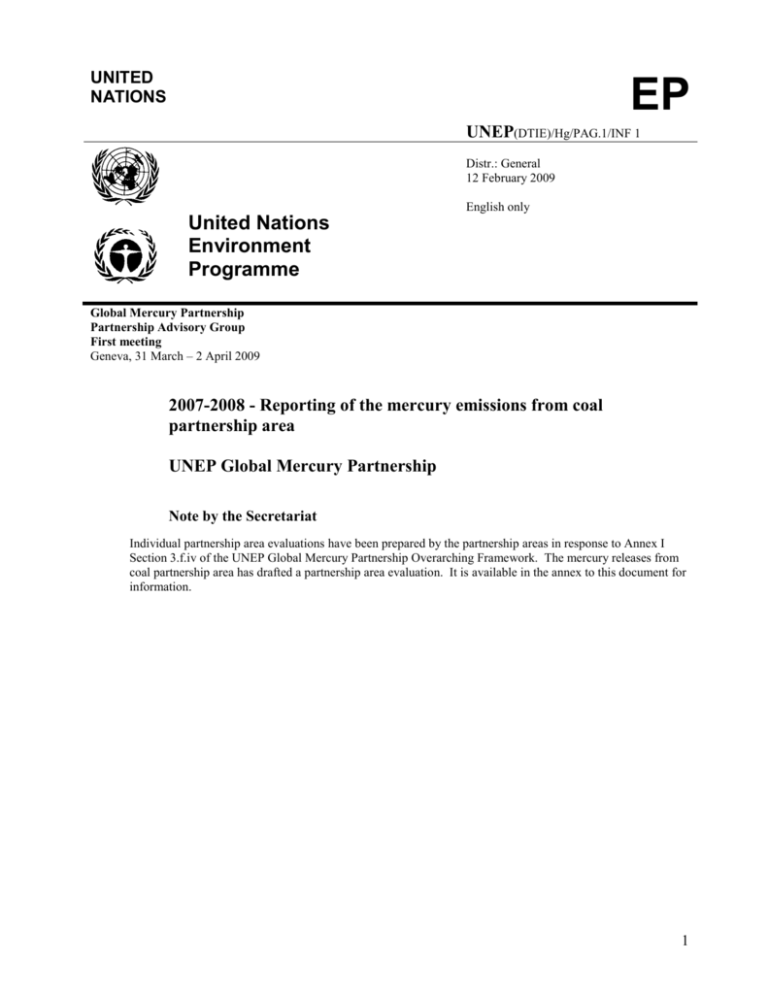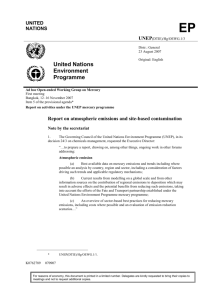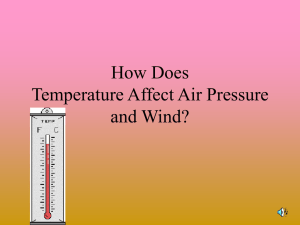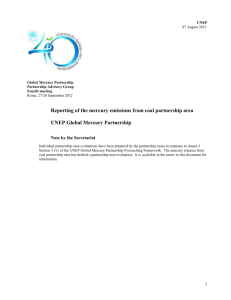Mercury releases from Coal Combustion
advertisement

UNITED NATIONS EP UNEP(DTIE)/Hg/PAG.1/INF 1 Distr.: General 12 February 2009 English only United Nations Environment Programme Global Mercury Partnership Partnership Advisory Group First meeting Geneva, 31 March – 2 April 2009 2007-2008 - Reporting of the mercury emissions from coal partnership area UNEP Global Mercury Partnership Note by the Secretariat Individual partnership area evaluations have been prepared by the partnership areas in response to Annex I Section 3.f.iv of the UNEP Global Mercury Partnership Overarching Framework. The mercury releases from coal partnership area has drafted a partnership area evaluation. It is available in the annex to this document for information. 1 Annex: 2007-2008 – Evaluation of the Mercury releases from coal partnership area 1. General Information 1.1 Individual partnership area: 1.2 Individual partnership area lead Mercury releases from Coal Combustion Dr Lesley Sloss, Principal Environmental Consultant, International Energy Agency, Clean Coal Centre (IEA CCC) 1.3 Reporting year/period: 2007-2008 1.4 How many meetings were held Number of face to face meetings: 1 over the reporting period? Number of teleconferences: 1 Other: Small –subgroup meetings 1.5 How many partners are part of 7 official partners with much informal support. this partnership area? A formal process of joining the partnership was established under the Overarching Framework. Partners are reminded to submit partnership support letters to UNEP. Information on joining the partnership can be found at: www.chem.unep.ch/mercury/partnerships/new_partnership.htm In-kind assistance from several experts from the MEC 1.6 How much funding was raised (Mercury Experts from Coal) group giving both time through this partnership area? What and expertise to work on the BAT/BEP proposal. about in-kind assistance? The European Commission has funded a project aimed at reducing Mercury Emissions from Coal combustion in the energy sector, starting in 2009. Details are included in monitoring performance, section 2.2 below. 1.7 What is the objective of the individual partnership area? The objective of this partnership area is continued minimization and elimination of mercury releases from coal combustion where possible. 2. MONITORING PERFORMANCE (tracking partnership activities and partner contributions) 2.1 Please provide a short overview of the key current partnership area efforts (brief description, expected outcomes, budget, timeframe). A BAT/BEP guidance document is being prepared for mercury control at coal-fired facilities in developing nations. The report should be available for publication in June/July 2009 and will be available on-line and in hard copy to all interested parties. The cost of the preparation of this document is just over 50,000 euros. Once completed, the BAT/BEP document will be circulated to organizations which would benefit. It may be possible to align this with international conferences to allow a work-shop type approach for guidance on its use. 2.2 Please provide a short overview of any key upcoming, planned partnership area efforts (brief description, expected outcomes, budget, timeframe). A 3 year, 1 million Euro project will be launched with funding from the European Commission aimed at reducing mercury emissions from coal combustion in the energy sector. It is hoped that this would eventually be expanded to include industrial boilers as well. This support will be used to support the activity related to mercury releases from coal combustion partnership area and will be used to inform broader global processes affecting Hg removal. More specifically the project aims to develop guidance 2 material on how to optimize multi-pollutant control techniques, including GHG’s and energy efficiency to reduce mercury-emissions; to collect information to improve accuracy of future emissions inventories for the sector; to implement pilot studies to demonstrate efficiency of co-beneficial techniques and to build local/national capacity on these issues, also with the aim of transferring information and lessons learned to facilities and governments in other countries. A new project using a computer model to evaluate and predict mercury emissions from typical Chinese coals and typical combustion systems has been proposed by a partner. A draft outline for emission measurement studies in developing countries and economies in transition has been prepared. It is proposed that, once funding is available, an initial study will be undertaken in South Africa. This already has the approval and support of the South African delegates from the last OEWG meeting in Nairobi. Similar studies would then be proposed in target areas in China. The Ukraine has also been identified as a possible initial target area because of its high coal dependency compared to the rest of Europe. 2.3 Please provide a short overview of key partnership area efforts completed since the previous Governing Council (brief description, outcomes, costs, timeframe). A report entitled “Economics of mercury control” was produced by Dr Lesley Sloss, IEA CCC. This document is published and sold through the IEA CCC but copies are made available free of charge to those who would benefit most. The report was produced free of charge as a gesture of partnership from the IEA CCC. China worked with the United States to hold a workshop in 2008 to focus on multi-pollutant control of coalfired power plants. The Multi-pollutant Workshop was held in Hangzhou, China on November 10 - 14, 2008. The workshop focused on cost effective controls that provide an integrated approach to the control of NOx, SOx, PM, Hg, and CO2. Since the meeting was ad-hoc, there have been no published reports produced. However, several Chinese participants agreed to sign up to the partnership and a representative was chosen for nomination to the Partnership Advisory Group. An ad-hoc meeting of partners and interested experts was held in Yantai, China, in November 2008 on the back of a US EPA meeting on multi-pollutant controls strategies. As a result of this meeting, further partners have been encouraged to join and an Chinese expert has been nominated into the advisory group. 3. ASSESSING EFFECTIVENESS (measuring the impact of partnership activities on target beneficiaries) 3.1 What are the partnership area indicators of progress? If no indicators, please specify why. Two specific indicators are currently identified in the business plan including: Availability of guidance tools to assist countries in achieving emission reductions. Emission reductions achieved. The setting of numerical targets to achieve under the partnership area may also be revisited, upon finalization of the UNEP report on atmospheric emissions (which includes information on trends). In 2009, the partnership area may wish to make a more advanced assessment of a baseline scenario and project a goal for 2015 (or beyond). Since estimates for mercury emissions from coal combustion are known to be somewhat inaccurate and difficult to quantify, it is perhaps not appropriate to use actual emission estimates and reductions therein as a target at this stage. Rather the initial proposed regional projects would be used to provide more accurate emissions for smaller target areas. Once the BAT/BEP document is finalized, projects based on its implementation will be promoted in these target areas. Data for these areas would be likely to be relatively accurate and this would allow target reductions to be set in a way that is more easily implemented and tracked. 3 3.2 Please report on progress in terms of each of the partnership area indicators outlined within the partnership area business plan. Guidance tools are under development. The partnership area has set itself goals for the development and distribution of BAT/BEP guidance documents and the instigation of new projects on mercury emissions from coal in the targeted countries. Funding is secured for follow up efforts. At the moment the inventories on mercury release in developing countries are known to be inaccurate and the rapid growth in coal use means that the data rapidly become out of date. However, the UNEP mercury inventory guidance document should improve this. Further, proposed work on modeling of mercury behaviour in Chinese plants could be expanded to include studies on Russian and Indian systems. This information could then be used to improve the accuracy of emission inventories in these areas. Until these inventories are established, it will not be possible to produce an accurate target for progress in terms of emissions (quantity). The number of partners registered is growing. 3.3 Please summarize the key results achieved to date by the partnership area in terms of the following areas (as applicable): i) Sharing and exchanging information: Report “Economics of mercury control” produced and distributed Report “BAT/BEP guidance for mercury control in developing nations” has been commissioned Mercury partners met at the MEC5 meeting in Newcastle, Australia, along with other mercury experts and used this collection of parties to produce the outline for the BAT/BEP guidance document Mercury partners and Chinese experts met in Yantai, China, in an ad hoc manner to openly discuss the complex challenge of estimating mercury emissions in China and how best to reduce emissions in future. New partners were gained and several projects for work were discussed with a view to proposing studies within China to be initiated in the near future. ii) Strengthening capacity: The number of partners is growing. Meetings of mercury partners are being aligned to coincide with other international meetings to allow as much interaction and communication as possible. iii) Other results you may wish to highlight: Interest in the partnership is strong. We have excellent links with conferences such as MEC, ICMGP and the US EPA multi-pollutant control meeting which should allow frequent and useful interactions among partners. 3.4 What are the strengths of the partnership area? The partnership has a strong and committed lead from both the US EPA and the IEA CCC who have excellent international expertise and contacts. E.g., US EPA is conducting Hg control project in Russia through the International Science and Technology Center in Moscow 3.5 What are the weaknesses and/or major challenges for this the partnership area? The major challenges for the partnership area include: - the production of accurate emission estimates for coal emissions in different areas and improvement in the understanding of the type of coals and combustion systems being used in these areas 4 - evaluating the potential for mercury control as part of existing and emerging legislation / action plans and as part of multi-pollutant strategies - determining those areas where the greatest reduction in emissions can be achieved - evaluating the future with respect to proposing further reaching, more mercury specific control strategies. 3.6 Can the weaknesses or major challenges be addressed through the partnership? If yes, what is the best strategy to address such weaknesses / major challenges in moving forward? The lack of accuracy in existing emission inventories makes it hard to produce valid estimates of current and future emissions from the coal sector. The rapid growth in this area, especially in countries such as China and India, mean that reducing emissions and even controlling future growth in emissions will be a challenge. However, the synergies and co-benefits that can be attained from legislation and action taken to reduce emissions of other pollutants, such as particulates, SO2 and NOx, are significant. Maximising these co-benefits could mean an average mercury reduction at many plants of over 70%. By aligning mercury control with the new efficiency improvement and emission reduction strategies in place in countries such as China, there is the potential for rapid reduction in mercury emissions at many plants in an economic manner. The partnership can call upon help from the excellent list of experts who have offered to help. There may be a limit to what can be achieved within a short timeframe with the limited budgets available. 3.7 In view of above, how should the partnership area be modifying its approach in the coming two year cycle? Should the objective and indicators of the partnership area be revised in moving forward? The partnership should continue with its current work but should seek funding to allow more work to be undertaken to deal with the issues discussed above. 3.8 Please specify whether the promotion of non-mercury technologies (where suitable economically feasible alternatives do not exist) is relevant to the partnership area, and if it is, how the partnership area is addressing this aspect. Although alternative fuels to coal are available, the choice of fuel used in developing nations is made based on cost and availability. Without legislative or other action, fuel switching is unlikely to occur as a result of any advice on mercury reduction alone. Promotion of NOx control is also relevant since many Nox control technologies provide concomitant co-benefit reduction of mercury. Programmes to reduce CO2 emissions and to improve energy efficiency provide the potential to reduce fuel use and emissions of all pollutants, including mercury, simultaneously. 3.9 Please outline how this report was drafted and who was consulted with in doing so? Drafted by the partnership area lead Dr Lesley Sloss, IEA CCC in consultation with UNEP and the partnership area (2 week comment period starting 21 January 2009). 4.0 This section is intended for other relevant comments. 5









